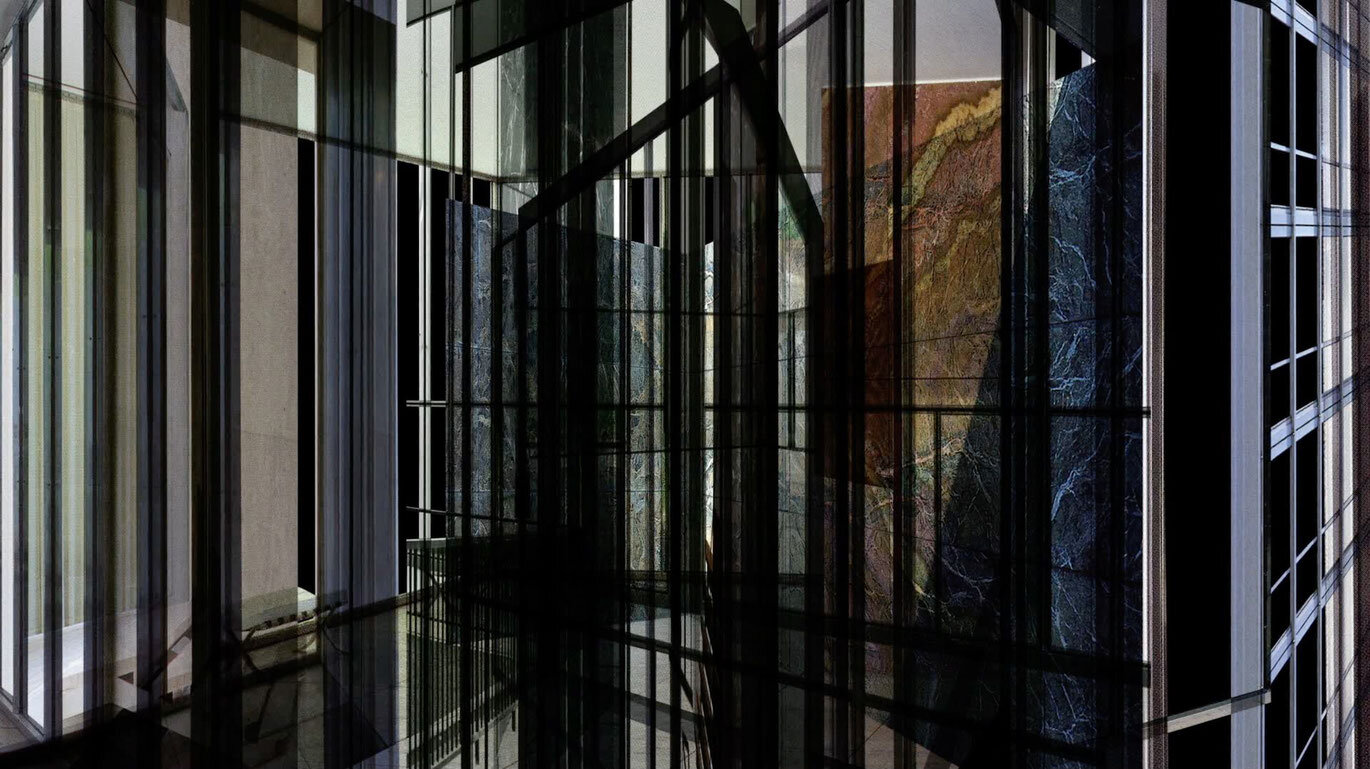ALT/KINO is covering this year’s online iteration of 25FPS via a series of correspondences between Patrick Gamble and Ben Nicholson about programmes in the festival’s competition strand. In our third instalment, Patrick writes to Ben about films in the ‘Dreamscapes’ programme.
Collapsing Mies (Claudia Larcher, 2020)
Hey Ben,
It’s great to hear from you. It’s been comforting to know we’re watching these films together, even if it’s from our respective homes. I have to admit that I was left a little cold the first time I watched Philipp Fleischmann’s Austrian Pavilion. However, after reading your correspondence, the film took on a new dimension. Watching it again, I really enjoyed how Fleischmann’s handmade camera makes the museum’s architecture resemble frames of celluloid - something I wouldn’t have noticed otherwise.
Fleischmann’s case for the inclusion of more moving image work in art galleries got me thinking about another film in the festival’s ‘Dreamscapes’ program; Claudia Larcher’s Collapsing Mies. A tribute to the German-American architect Mies van der Rohe, it could be argued that Larcher’s film suggests we dismantle these cathedrals of culture entirely. Overlaying 2D images of The New Gallery in Berlin, the film creates a hypnotic 3D image of Mies’ most famous structure. Doors, windows, and walls overlap in a rhythmic dance in which the exterior and interior intersect so that the barriers that often make art feel inaccessible are broken down and disassembled like flatpack furniture. I’m aware my reading of the film probably says more about my own relationship to art galleries than Larcher’s, but positioned against Fleischmann’s film it makes for a compelling argument for the need to reevaluate how we use these spaces.
I’d also like to thank you for pointing me in the direction of Victoria Schmid's A Proposal to Project in Scope. During lockdown, I’ve come to know my nearest green spaces pretty well – my current favourite is the bird hides at the Middlesex Filter Beds Nature Reserve – and I enjoy how the constant flux of bird song can make these locations feel different every time I visit. Like Schmid, I often wonder if it’s possible to really represent these natural landscapes on screen. However, I would argue that Noemi Osselaer’s Erpe-Mere comes pretty close. A film that allows us to awe at the beauty and other-worldliness of the countryside, it opens with scenes of agricultural labour in a quiet rural village, before switching to the perspective of a young girl as she falls asleep to the sound of the insects and wildlife outside her tent. From here we’re drawn into a cinematic nocturne, where unbridled wilderness and wildlife thrive in a space where human traces have been almost erased entirely. Creeping steadily from stillness to anarchy, it reminded me of Scott Barley's Sleep Has Her House and to a lesser extent, the way Apichatpong Weerasethakul depicts the natural world as both therapeutic and prone to metaphysical flights of imagination. The film ends with a thank you, to “all the animals who appeared in front of my camera and made beautiful sounds for me.” The fact Osselaer doesn’t credit them all individually gives you an idea of the cacophony of noise that accompanies this transcendental voyage through this ‘sleepy’ Flemish village.
The thing that struck me most about the films in the ‘Dreamscapes’ program was their ability to imbue concrete realities with the weightlessness and radiance of the dreamworld. This was perhaps best observed in Simon Liu’s Signal 8. You first introduced me to Liu’s work at this year’s Ann Arbor film Festival, where E-Ticket screened virtually. It was my first digital festival of the pandemic. At the time it felt novel and exciting, but I didn’t know it was a warning of how I would attend festivals in the future. Signal 8 also feels like a premonition. Like a dream that howls with intent about some impending disaster, the source of which you can’t quite put your finger on. Liu has made several films from the footage he’s shot during his regular visits to his family in Hong Kong, and Signal 8 uses this material to create a film that’s part city symphony, part disaster movie - albeit one with no second act. These 16mm images of the city are heavy and malodorous with trepidation, like the smell of summer rain on concrete before a storm. Saturated street lighting, ominous radio transmissions and a haunting rendition of Be My Baby over the sight of fireworks exploding across the city all make it feel like Hong Kong is on the brink of disaster. Signal 8 was filmed before the 2019 extradition bill that instigated the recent protests in the former British colony, but Liu’s kaleidoscope of menace and unease suggests that perhaps there’s still something worse looming on the horizon.
One of the films I was most excited to catch at this year’s 25FPS was Ismaël Joffroy Chandoutis’ Maalbeek. I first encountered Chandoutis when his stunning debut, Swatted (teaser) - a cinematic exploration of the phenomenon in which gamers call-in bogus 999 calls so armed officers raid the homes of their live-streaming opponents - at Matt Turner’s ‘Is This a Game to You?’ event at the BFI last year. His latest pivots quite dramatically from the world of online harassment to global terrorism. The film follows Sabine, a survivor of the 2016 Brussels bombing. She went into a coma following the explosion and suffered brain damage that led to her losing her memory. A haunting study of how the human brain can both reminds us and shield us from trauma, the film is composed of a rich tableau of impressionistic shots of the station in which the lines that define objects are blurred and indecipherable; with light and colour used to capture the momentary and transient relationship between memory and space. Archival news footage helps give these images meaning, but Sabine’s attempts to remember the event are constantly met by the collective amnesia of a society trying to forget. Speaking of the forgotten and the fragmentary stories that make up a city, Maalbeek is a fascinating study in how moments of collective trauma shatter our fundamental assumptions about security and invulnerability and force us to see the world differently.
Before I leave you to round up the ‘Visions’ section of the program, I’d like to recommend Suneil Sanzgiri’s At Home But Not At Home. Preoccupied with the way in which technology materialises memory, Sanzgiri combines 16mm films of his family’s village in Goa with drone footage, desktop screenshots and zoom conversations with his father to question the constructs of identity and colonialism. I think it’s something you’ll definitely dig.
Until next time,
Patrick
The 2020 edition of 25FPS Festival ran from 24 - 27 September
Patrick Gamble is a writer on film and culture, whose work has featured on Hyperallergic, BFI, Calvert Journal and Kinoscope. Further links to his writing can be found at patrickgamble.contently.com.

